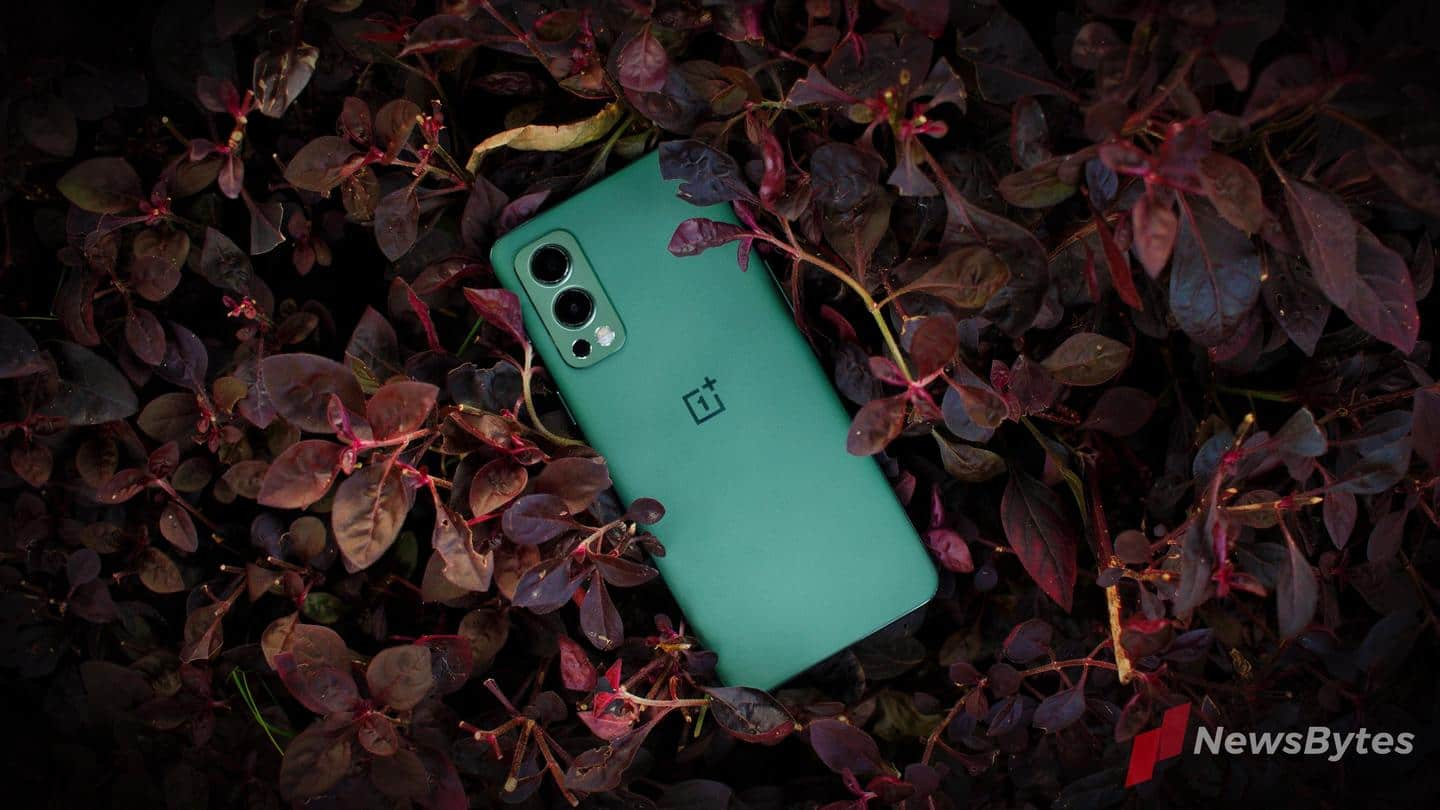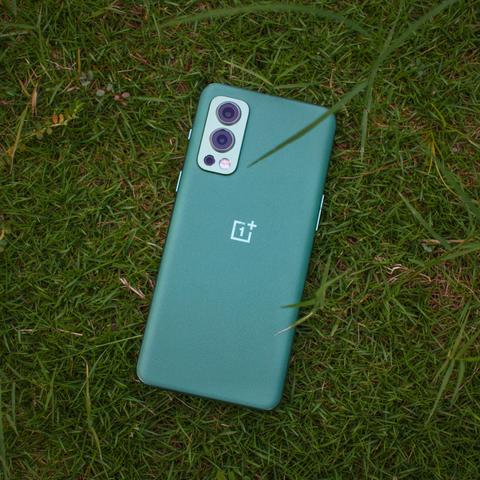
OnePlus Nord 2 5G Review: Top-tier performance at mid-range price?
What's the story
The OnePlus Nord 2 5G is being marketed as the device that would fill in the shoes of the original OnePlus Nord and do a better job. However, stiff competition from Xiaomi's POCO F3 GT, the cheaper OnePlus 9 series, and the Samsung Galaxy A52 5G makes a fine case for explaining where the Nord 2 shines and where it doesn't. The OnePlus Nord 2 comes in three colors and three variants with a starting price of Rs. 27,999 for 128GB of storage coupled with 6GB of RAM. An additional Rs. 2,000 bumps up the RAM capacity to 8GB. You will have to part with Rs. 35,000 for the top-of-the-line model that we have reviewed. It packs 12GB of RAM and 256GB of storage, but with no room for expandable storage. Does it outdo the competition and is it better than the original Nord? Read on to know more.
Well-executed
Design and build quality: Premium feel minus fingerprint magnet surfaces
The OnePlus Nord 2 5G's plastic frame and leather-textured back are unmistakable. The plastic back is exclusive to the Green Wood color available for the top-of-the-line variant. The cheaper variants get a matte-finish Corning Gorilla Glass 5 back, just like the screen. The gloss finish on the plastic side rails attracts fingerprints but nicely complements the frosted aluminium chassis that can be seen enveloping the cameras. The device feels a tad bit heavy in the hand, but the screen is narrow enough to reach across with your thumb. The power button on the right and the volume rocker on the left are placed intuitively within easy reach and offer tactile feedback. The Alert Slider, as OnePlus likes to call it, has a knurled finish. An intermediate position for vibrate mode between ring and silent is a welcome touch. The camera array protrudes by 2.1mm and the phone rocks when laid flat. The in-display fingerprint reader and stereo speakers work well but we do miss a 3.5mm headphone jack. There are no earphones in the box either, wired or otherwise. The included case protects the screen with a lip and has frosted sides that don't attract fingerprints. The vibration motor responsible for haptic feedback deserves special mention here. It delivers short, sharp knocks for actions like device unlocking and typing but also feels like a premium mouse wheel with subtle vibration feedback when scrolling in some apps. Importantly, it remains inaudible and discreet even when alerting for incoming calls. The SIM tray takes one nano-SIM on the top and one on the underside but there is no SD card slot. Unless you are on a budget, we recommend you get the 256GB variant, especially if you plan to install several games. There is no IP rating for the Nord 2 unlike the Galaxy A52 and the POCO F3 GT but rubber seals for ingress protection are provided on the SIM tray.
Absolute unit
Display and Specifications: No compromise?
The OnePlus Nord 2 sports a 6.43-inch Full-HD+ resolution (2400x1080 pixels) Fluid AMOLED display with an impressive pixel density of 410 pixels per inch (ppi). The panel has a 90Hz refresh rate (switched on by default) and support for HDR10+ content. The in-display fingerprint sensor is conveniently positioned and didn't falter in our testing. This isn't a flagship-spec display in terms of smoothness or resolution but its color accuracy is remarkable, delivering crisp blacks and sharp contrast thanks to the underlying AMOLED technology. The display was mostly legible in bright daylight with the brightness at or above the indicated 70% mark. Direct sunlight did impact readability, but the 90Hz refresh rate ensured a smooth stutter-free experience consistent across the user interface. The OnePlus Nord 2 boots Android 11 out-of-the-box and uses an eight-core MediaTek Dimensity 1200-AI processor under the hood coupled with LPDDR4X RAM and UFS 3.1 storage powered by a 4,500mAh dual-cell battery. The CPU has a bank of four cores that can reach clock speeds of up to 2GHz, another cluster of three cores limited to 2.6GHz, and the last remaining core being capped at 3GHz. Graphics duties are handled by the ARM Mali-G77 MP9 GPU. The name clearly indicates that the 5G cellular band is supported (on both SIM cards). For connectivity, the OnePlus Nord 2 gets Wi-Fi6, NFC, and Bluetooth 5.2 with support for AptX, AptX HD, LDAC, and AAC codecs. A USB Type-C port with support for OTG is also seen.
Great for gaming
Performance: OnePlus Nord 2 5G doesn't disappoint for the price
The OnePlus Nord 2's MediaTek Dimensity 1200-AI is a direct rival to the powerful Qualcomm Snapdragon 865 chip from last year. The performance leaves no room for complaint. We played Call of Duty Mobile for 30 minutes and the battery fell from 91% to 83%. The back of the device got a bit toasty beside the camera array, reaching a temperature of 42 degrees Celsius. There was no stuttering and frame drops even after long gaming sessions. While your experience may vary, we ensure the repeatability of our tests using acclaimed benchmarks to evaluate performance qualitatively. On the 20-minute long 3DMark Wild Life Extreme Stress Test designed to evaluate performance and thermal management under sustained heavy load, the OnePlus Nord 2 5G scored 1,282 points on its best loop score. Here, the POCO F3 performed slightly better than the Nord 2, but both devices decimated the Samsung Galaxy A52 5G's score. On the Wild Life test that simulates a short burst of intense activity, the Nord 2 scored 4,180 points, outdoing both the Samsung Galaxy A52 5G and the POCO F3 GT by a handsome margin. This indicates that the POCO F3 GT handles sustained intensive loads marginally better than the OnePlus Nord 2 and both devices blow the Samsung out of the water with short bursts of performance. The PCMark Work 3.0 performance test evaluates how a smartphone performs while handling conventional everyday tasks like web browsing, image editing, and video editing. The OnePlus Nord 2 5G scored 8,554 points here, outdone by the POCO F3 GT and the Samsung Galaxy A52 5G, but only by a small margin. On the PCMark Storage 2.0 benchmark that evaluates how fast the onboard storage is, the OnePlus Nord 2 scored 20,139 points. The POCO F3 GT performed better than the OnePlus Nord 2 and embarrassed the Samsung Galaxy A52 5G.
Warp Charge 65
Rapid charging, software experience work in Nord 2's favor
The OnePlus Nord 2 5G's performance does chew through the battery rapidly. Thankfully, a 65W Warp charger with the signature red cable comes bundled and 58% of the battery gets recharged in just 15 minutes. The battery gets fully replenished in approximately 35 minutes. Notably, neither the power brick nor the OnePlus Nord 2 5G heated up during charging. During our testing using the Nord 2 as a daily driver, we were able to get through the day easily with around 20% to spare. That said, your mileage may vary. Do note that the high-wattage charger could degrade the battery over time, causing it to drain out faster as it gets older. The OnePlus Nord 2's software experience leaves little to complain about, save a few fixable inconveniences. The OxygenOS 11.3 skin based on Android 11 delivers a smooth, consistent, and bug-free experience. A slew of innovative features are available, too, including a video enhancement mode, Zen mode, optimized night charging, sleep standby optimization, and a high-performance mode. The high-performance mode impacts battery consumption and makes the device run hotter, but does improve the overall performance noticeably. A special mention must be made of the ability to add OS-level gestures for when the screen is off. One can assign unlock, call, or app opening actions to one of the listed gestures. On the homescreen, the swipe-down gesture opens a Shelf by default where OnePlus promotes its cloud storage and provides other non-essential details. One must tediously change the swipe-down gesture to open the notification shade and quick settings panel via the launcher settings. Another mild, and thankfully fixable, disappointment is the pre-installed bloatware apps, including Netflix, Spotify, Google One, and Google Podcasts. While the wider internet hates the new system-wide OnePlus Sans font, we didn't find it jarring to adapt to. Overall, the Nord 2 delivers a polished, ad-free user experience.
Clear as day
Camera performance: Primary sensor stays consistent, ultra-wide struggles
In the camera department, the OnePlus Nord 2 5G features a 50MP Sony IMX766 sensor as the primary camera with optical image stabilization (OIS), a six-part lens design, and an aperture of f/1.88. The secondary camera is an 8MP ultra-wide camera with a field of view (FOV) of 119.7 degrees. This lens features electronic image stabilization (EIS) and an aperture of f/2.25. The primary sensor delivers impressive shots in broad daylight. Turning HDR mode on improves images slightly, lending more details to the highlights. Colors are vivid yet balanced and accurately represented, even in the 50MP shots. The camera performs well for its price in artificial indoor lighting situations, too. However, the same cannot be said for the ultra-wide camera. In bright natural and artificially lit scenes, the camera struggles to capture details in highlights unless HDR is turned on. The shadows are darker than we would like and the stock camera app tends to over-sharpen images, too. The third lens on the back is a 2MP monochrome f/2.4 lens that we couldn't use via the camera app. The edge detection works impressively with both objects and people. Portrait mode, meanwhile, works well on the OnePlus Nord 2 5G. The front-facing camera is a 32MP Sony IMX615 sensor with EIS and an aperture of f/2.45. The images are crisp, have sufficient details, and don't falter in low light either. Portrait mode delivers good results repeatedly and the AI enhancements allow for multi-step beauty (smoothening) adjustments if you use it.
The dark side
Low-light and video performance: Ultra-wide lens unsatisfactory for the price
At night and in low-light conditions, the primary camera continues to deliver phenomenal details and clarity, especially when HDR mode or Night mode is enabled. The ultra-wide camera's relatively narrower aperture translates into lesser details in shots. Switching on HDR or Night mode enhances the highlights of the image but doesn't do much to help the obliterated details in the shadows. Long story short, give the ultra-wide camera plenty of light for optimal performance but don't count on it once the sun sets. The primary camera is a better all-rounder, unencumbered by excessive image processing. The OnePlus Nord 2 5G can shoot 4K video at 30fps and 1080p video at up to 60fps. The primary and ultra-wide cameras impressed us in this regard, with both quickly adapting to changes in ambient lighting and tracking focus for objects in the frame. The primary camera's OIS prevents sharp jerks from destabilizing the video, making hand-held recording a breeze. While shooting images of objects close to the camera does not pose any issues, the video mode tends to hunt for focus in close range if the camera is not held steadily and moved smoothly.
Conclusion
This is OnePlus's latest attempt repeating what it does best
In summary, the OnePlus Nord 2 5G is a quintessential OnePlus device that delivers performance rivaling phones that cost nearly twice as much. The device is better than the original Nord and a great option for someone looking for a mid-range smartphone with good performance, build quality, and 5G readiness. It outperforms the Samsung Galaxy A52 5G across the board and fares very close to the POCO F3 GT, bringing the consumer's final choice down to personal preference.
